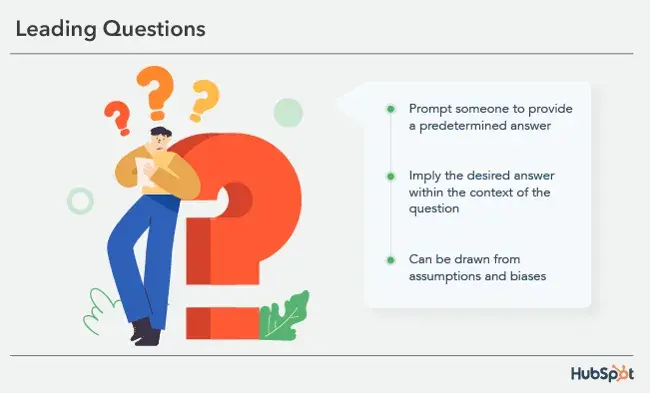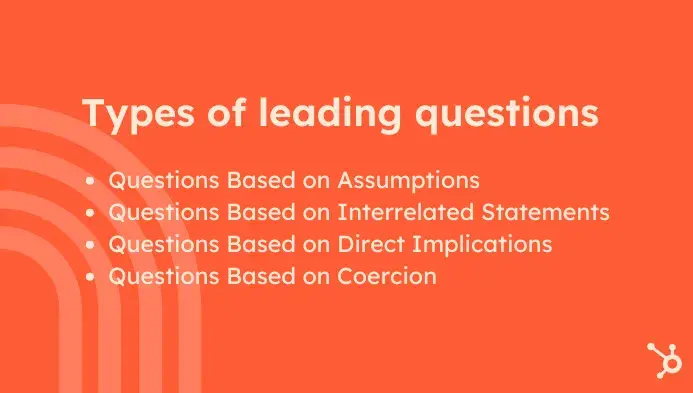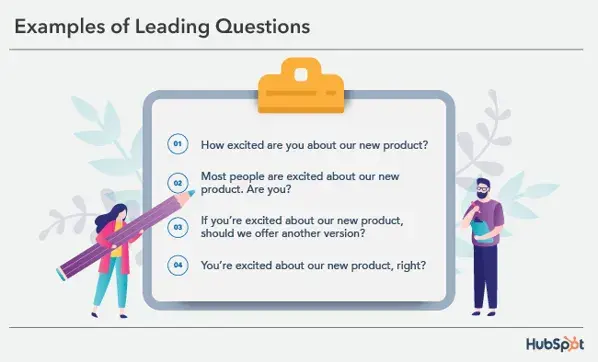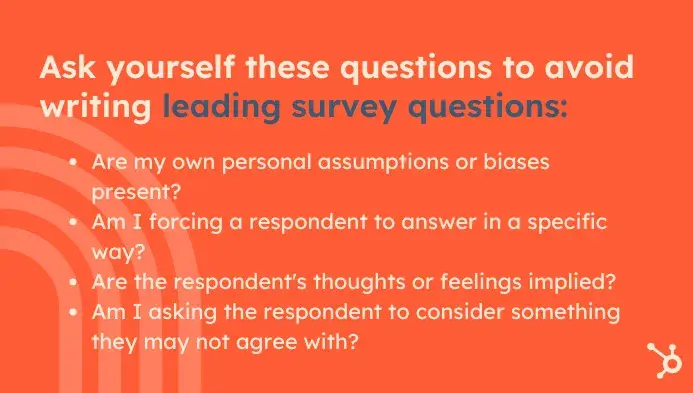In this article, I want to dive into what leading questions are — specifically leading survey questions — and emphasize why identifying and ditching them is so critical, especially when you’re after honest-to-goodness feedback.
In this article:
- What are leading questions?
- Types of Leading Questions
- Leading Questions vs. Loaded Questions
- Examples of Leading Questions I’ve Encountered
- How to Avoid Leading Questions
- Why You Should Avoid Leading Survey Questions
- The Lesson: Don't Lead Your Customers On
What are leading questions?
A leading question prompts someone to provide a predetermined answer. In other words, the desired answer is implied based on the context and phrasing of the question.
For me, a leading question is one that subtly (or not-so-subtly) guides someone toward the answer, or one the researcher might want to hear. The desired answer is kind of baked right into the phrasing or the context.
Because leading questions draw from assumptions and biases, they tend to lead to unreliable survey results — and that can be bad for business.

I see leading questions pop up a lot in surveys. Often, they contain information or assumptions the surveyor wants to confirm or deny. But instead of letting you answer freely, the question nudges you in a particular direction.
Why does this matter? Because relying on feedback from leading questions can lead to seriously skewed results. If your data is based on assumptions and biases rather than genuine opinions, the decisions you make based on that data could be shaky.
Let’s say I’m trying to figure out how customers really feel about my product’s ease of use. If I send out a survey asking something like, “How satisfied are you with how easy and simple our product is to use?” – well, I’m probably not going to get the unvarnished truth from folks who are actually struggling.
That kind of honest, critical feedback is gold because it highlights potential problems that might be causing others to leave (churn). It’s estimated that businesses lose more than $5 million annually due to decisions based on inaccurate data, with 7% reporting they lose $25 million or more, making unbiased feedback collection essential.
That’s why I believe crafting clear, neutral survey questions is fundamental to getting useful results.
Pro tips:
- Always strive for neutral wording. I make it a point to strip out subjective adjectives (like “wonderful,” “amazing,” “terrible”) and leading adverbs because they instantly introduce bias into the question.
- Keep your questions simple and focused. Try to ask about only one thing per question. Combining multiple ideas can unintentionally lead the respondent or make the question confusing.
Now, let’s get into the various types of leading questions.
Types of Leading Questions
- Questions Based on Assumptions
- Questions Based on Interrelated Statements
- Questions Based on Direct Implications
- Questions Based on Coercion
I’ve noticed leading questions tend to fall into a few common categories. Recognizing these types helps me avoid writing them myself.
Questions Based on Assumptions
This kind of leading question presumes the respondent thinks or feels a certain way.
These types of questions tend to lean positive and use phrases like:
- How much do you like X?
- How delighted are you with Y?
Pro tip: Before finalizing a question, ask yourself: Am I assuming anything about the respondent’s feelings, experiences, or knowledge? If the answer is yes, rephrase the question to remove that assumption. Instead of assuming they liked something, ask them how they would rate it.
Questions Based on Interrelated Statements
With these kinds of questions, I might see a statement of fact or opinion followed by a question tied to it.
These types of questions tend to use phrases like:
- [Insert statement]. What are your thoughts?
- [Insert statement]. How do you feel about this?
While sometimes useful for gauging agreement, if I’m not careful, the initial statement can heavily influence the answer.
Pro tip: Avoid pairing a strong opinion or potentially biased statement directly with a question asking for a related feeling or thought. If you need to provide context, keep it strictly factual and neutral, and clearly separate it from the question itself, perhaps by putting it in a preceding sentence.

Questions Based on Direct Implications
These questions ask respondents about the future consequences of a current attitude or action, whether it applies to them or not.
These types of questions tend to use phrases like:
- If you liked X, should we do it again?
- If you subscribed to X, will you be subscribing to Y?
This gets awkward if the person didn’t like X.
Pro tip: Steer clear of “if/then” questions that hinge on assumed feeling or action. Instead, ask separate questions. First, determine the respondent’s actual attitude or behavior (e.g., “How did you feel about X?”). Then, ask a separate question about future possibilities (e.g., “What new options related to X would you like to see?”).
Questions Based on Coercion
These questions use language that practically forces agreement.
These types of questions tend to use phrases like:
- You enjoyed X, didn't you?
- Our product is great, right?
I find these are among the worst offenders for bias, as they leave very little room for honest disagreement.
Pro tips:
- Instead of coercion, leverage rating scales like Likert scales to avoid coercive language or forcing simple Yes/No answers where nuance is needed. Scales give respondents the freedom to express their true feelings more accurately.
- After getting a rating or a specific answer on a survey, sometimes the most valuable insight comes from a simple, open-ended follow-up question like: “Why did you give that rating?” or “Could you tell me a bit more about that?” This gives respondents space to explain in their own words, providing richer context.
Leading Questions vs. Loaded Questions
People often ask me about loaded questions, too, as they’re another type to avoid. While similar, I explain the difference like this:
A leading question nudges you toward an answer, while a loaded question contains an assumption (often controversial or unjustified) about the respondent within the question itself.
Loaded questions often use emotionally charged language or make leaps in logic.
- Example: “Do you find it difficult to hide your imposter syndrome?”
This question is “loaded” because it implies that the respondent has imposter syndrome. These kinds of questions can really put respondents on the defensive because of the built-in assumptions.
While both are bad for neutral surveys, I find loaded questions often feel more like a trap.
Examples of Leading Questions I’ve Encountered
Here are a few examples that break down the types of leading questions we just discussed.
Example 1: Assumptions
Question: “How excited are you about our new product?”
Why I see it as a leading question: It assumes I am excited, rather than asking how I feel neutrally.
Example 2: Interrelated Statements
Question: “Most people are excited about our new product. Are you?”
Why I see it as a leading question: The first sentence creates social pressure to agree.
Example 3: Direct Implications
Question: “If you're excited about our new product, should we offer another version?”
Why I see it as a leading question: It links a future decision to an assumed present feeling.
Example 4: Coercion
Question: “You're excited about our new product, right?”
Why I see it as a leading question: The “right?” pushes strongly for a “yes.”
Now, I do see leading questions used intentionally, and sometimes effectively, in other contexts:
Example 5: Marketing
Marketers might use them to create buzz or social proof.
Question: “Thousands of customers are loving our new ebook. Are you ready to download your copy?”
Why it’s used: The initial statement aims to persuade by highlighting popularity.
Example 6: Sales
I’ve seen sellers use them to move a prospect towards closing.
Question: “So, shall we set up your subscription starting Monday?”
Why it’s used: It assumes the decision to buy has already been made, making it harder to back out.
Example 7: Legal
Lawyers sometimes use them strategically (within rules) to guide testimony. However, for gathering unbiased feedback, especially from customers? I steer clear.
Question: “How fast was the other car going when it ran the red light?”
Why it’s used: It assumes the light was red and the other car ran it.

How to Avoid Leading Questions
The best way to avoid leading questions is usually by reframing the question through a more objective lens. For example, the assumption-based question: “How excited are you about our new product?” would be better framed as “How would you rate our new product?”
Why?
By removing the assumption that the customer is excited about the new product, you give the customer the freedom to rate the product honestly — even if that means they're not that jazzed about it.
Here are some questions you can ask yourself to avoid writing leading questions:
- Are my own personal assumptions or biases present?
- Am I forcing a respondent to answer in a specific way?
- Are the respondent's thoughts or feelings implied?
- Am I asking the respondent to consider something they may not agree with?
Pro tip: If you’re looking for a hand while crafting neutral questions, templates can be a real time-saver. HubSpot offers a helpful set of customer satisfaction survey templates that incorporate many best practices for avoiding bias. They can help keep your questions on the right track.

Why You Should Avoid Leading Survey Questions
We touched on it already, but let me explicitly break down why I think leading questions are so problematic when you’re after genuine insights.
1. They pollute your data.
This is the big one for me. Leading questions introduce bias — plain and simple. They encourage respondents to answer based on the question’s framing, not their true feelings. This means the data you collect isn’t an accurate reflection of reality.
Pro tip: Treat every question draft as potentially biased. Actively read it from the perspective of someone holding the opposite view you might expect. Does the wording make it harder or more awkward for them to answer honestly? If so, revise for neutrality.
2. They lead to poor decisions.
If your data is skewed, any decisions you make based on it – product updates, marketing strategies, customer service improvements – might be misguided. You could end up investing resources in the wrong areas because you misunderstood your audience’s actual needs or opinions.
Pro tip: Remember the “garbage in, garbage out” principle? The cost of fixing a bad decision on flawed data (e.g., rolling back a feature, changing marketing spend) is almost higher than the effort required to collect unbiased data upfront.
3. They frustrate respondents.
Being nudged towards an answer you don’t agree with can be off-putting. It can make people feel like their genuine opinion isn’t valued, which can lower survey completion rates and even damage their perception of your brand. Research suggests response rates can drop when surveys feel biased or manipulative.
Pro tip: Value your respondents’ time and intelligence. A well-crafted, neutral survey signals respect for their genuine opinion. This not only improves data quality but also strengthens their relationship with your brand, making them more likely to offer feedback in the future.
4. They mask critical problems.
By encouraging positive or specific answers, leading questions can hide underlying issues. Like my product example earlier, asking about the “easy and simple” use might prevent you from discovering that a significant number of users find it confusing.
Pro tip: Embrace negative or unexpected feedback – it’s often where the most valuable learning lies. Purposefully frame questions neutrally to uncover potential problems, rather than seeking confirmation of success.
5. They undermine trust.
Consistently using leading questions can make it seem like you’re not interested in honest feedback, just validation. This erodes trust between you and your audience.
Pro tip: View every survey as a conversation and a brand touchpoint. Asking questions that feel manipulative or biased sends a message that you aren’t genuinely listening. Prioritize building trust through open, fair questions – the honest insights will follow.
Getting unbiased, truthful feedback is just too important to risk compromising it with poorly phrased questions.
The Lesson: Don't Lead Your Customers On
Leading questions might have their place in sales pitches or marketing stunts, but when I’m trying to understand my customers, I leave leading questions at the door. For me, feedback is pure gold. It drives improvement and helps build stronger relationships. But to get that value, I need to ensure the feedback is genuine and untainted by my own biases reflected in the questions.
Aiming for clear, neutral, and unbiased survey questions is always my goal.
The bottom line: Leading questions may work for sales, marketing, and even legal, but try to leave them out of your customer surveys.
Even if the underlying goal is to test an assumption, this may push respondents to answer in the direction of that assumption.
Questions Based on Interrelated Statements
Questions that use interrelated statements include a statement of fact or opinion, followed by a question that prompts a related answer from the respondent.
These types of questions tend to use phrases like:
- [Insert statement]. What are your thoughts?
- [Insert statement]. How do you feel about this?
Questions in this format can be useful to measure how much a respondent agrees or disagrees with a particular statement. But, if framed incorrectly, it may also encourage the customer to answer based on the information provided in the original statement.
Questions Based on Direct Implications
Direct implication questions require the respondent to determine the future implications of a present attitude or behavior — whether it applies to them or not.
These types of questions tend to use phrases like:
- If you liked x, should we do it again?
- If you subscribed to x, will you be subscribing to y?
But what happens if the respondent didn't "like" or "subscribe" to x? It makes it difficult for them to answer the question accurately.
Questions Based on Coercion
Questions that include coercive language usually force the respondent to affirm or agree with something.
These types of questions tend to use phrases like:
- You enjoyed x, didn't you?
- Our product is great, right?
Coercive questions are among the biggest contributors to survey bias because they sway respondents to provide a predetermined answer. There's little room for people to answer differently (and comfortably).
Leading Questions vs. Loaded Questions
Loaded questions are often mentioned along with leading questions when talking about things to avoid. Loaded questions are trick questions that contain assumptions about the respondent within the questions and often have exaggerations or emotionally charged language.
Example of a loaded question:
"Do you find it difficult to hide your imposter syndrome?"
This question implies that the respondent has imposter syndrome. The assumptions made asking loaded questions can put respondents off.
Now, let's get into a few examples of leading questions.
Leading Questions Examples

Here are some examples of the different types of leading questions that may unintentionally end up in your surveys (also highlighted in the image above).
Example 1: Assumptions
Question: "How excited are you about our new product?"
What makes it leading?
This question assumes that the respondent feels excited about the product.
Example 2: Interrelated Statements
Question: "Most people are excited about our new product. Are you?"
What makes it leading?
This question may prompt a particular answer (in this case, yes) based on the closely connected statement that most people are excited about the new product.
Example 3: Direct Implications
Question: "If you're excited about our new product, should we offer another version?"
What makes it leading?
This question forces respondents to consider the future implications of whether or not they feel excited about the new product.
Example 4: Coercion
Question: "You're excited about our new product, right?"
What makes it leading?
This question compels the respondent to agree that they're excited about the product.
But leading questions aren't all bad. In fact, they're commonly leveraged in marketing, sales, and legal contexts.
Example 5: Marketing
Marketers may use leading questions to help promote a product or service.
Question: "Customers love our new e-book. Are you ready to download a copy?"
Why It's Used:
This statement establishes that other customers love their book to help persuade new customers to purchase.
Example 6: Sales
Salespeople may use leading questions to persuade a prospective customer to buy a product or service.
Question: "When would you like to start your subscription with us?"
Why It's Used:
This question corners recipients into starting a subscription by assuming they're already on board to sign up.
Example 7: Legal
Lawyers may use leading questions to nudge the case in a specific direction (i.e., in their favor).
Question: "How late did the defendant get home that night?"
Why It's Used:
This leading question assumes the defendant got home late, which plays into whatever strategy the legal team has.
Still, you'll want to avoid using leading questions in your surveys. Let's discuss how to do that next.
How to Avoid Leading Questions
The best way to avoid leading questions is usually by reframing the question through a more objective lens.

For example, as shown in the image above, the assumption-based question: "How excited are you about our new product?" would be better framed as "How would you rate our new product?"
Why? By removing the assumption that the customer is excited about the new product, you give the customer the freedom to rate the product honestly — even if that means they're not that jazzed about it.
Here are some questions you can ask yourself to avoid writing leading questions:
- Are my own personal assumptions or biases present?
- Am I forcing a respondent to answer in a specific way?
- Are the respondent's thoughts or feelings implied?
- Am I asking the respondent to consider something they may not agree with?
- Do I feel strongly in one direction about this subject, and does it show?
Don't Lead Your Customers On
Businesses thrive off of customer feedback. And it's important to give your customers the opportunity to communicate with you openly and honestly.
The bottom line: Leading questions may work for marketing, sales, and legal, but try to leave them out of your customer surveys.
Editor's note: This article was originally published in September 2022 and has been updated for comprehensiveness.
Survey Creation
.png?width=112&height=112&name=Image%20Hackathon%20%E2%80%93%20Horizontal%20(24).png)

.webp)
![16 best free online survey makers and tools [+ recommendations]](https://53.fs1.hubspotusercontent-na1.net/hubfs/53/free-online-survey-maker-1-20251028-2654831.webp)


![How to conduct survey analysis like a data pro [all my tips + secrets]](https://53.fs1.hubspotusercontent-na1.net/hubfs/53/survey-results-1-20241031-6355381.webp)
![How long should a survey be? The ideal survey length [New data]](https://53.fs1.hubspotusercontent-na1.net/hubfs/53/how%20long%20should%20a%20survey%20be_featured.png)




![What Is a Likert Scale? [Examples & Templates]](https://53.fs1.hubspotusercontent-na1.net/hubfs/53/likert-scale-1-20241031-1487623.webp)